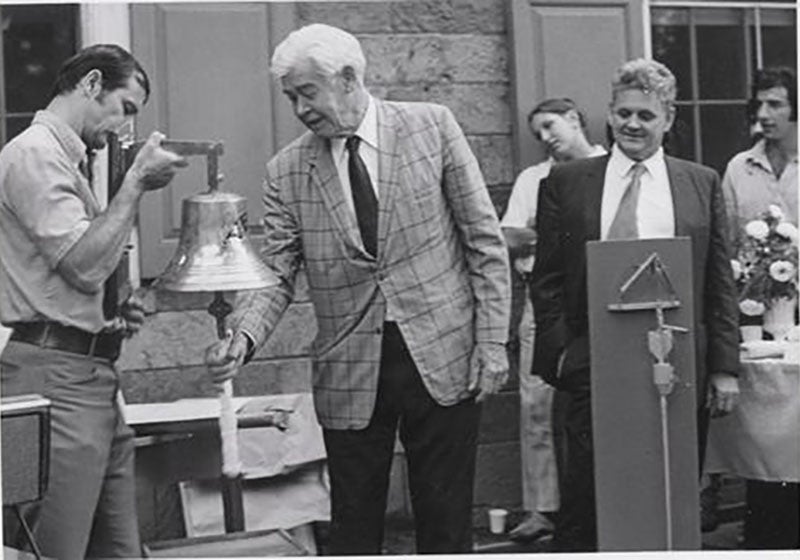Ewing and Worzel Graduate Fellowship
The Ewing and Worzel Graduate Fellowship was established by the Board of Regents of The University of Texas System on June 12, 1987, for the benefit of the Jackson School of Geosciences. Gift funds were provided by the Roland and Jane Blumberg Foundation of Seguin, Texas, ConocoPhillips of Houston, Texas, Mobil of Dallas, Texas, Palisades Geophysical Institute Inc. of Port Saint Lucie, Florida, and the Shell E & P Technology Company of Houston, Texas.
W. Maurice (“Doc”) Ewing, PhD was born in Lockney, Texas, on May 12, 1906. He received a BA in physics and mathematics from Rice Institute in 1926, an MA in 1927, and a PhD in 1931. His career included posts at the University of Pittsburg, Lehigh University, the Woods Hole Oceanographic Institution. he was instrumental in founding the Lamont-Doherty Geological Observatory at Columbia University.

Dr. Ewing and Dr. Worzel with the “Vema” bell in front of Lamont Hall,late 1960s
J. Lamar Worzel, PhD was born on February 21, 1919, on Staten Island, New York. He was a pioneering geophysicist and engineer who helped shape human understanding of how sound travels through the oceans, and co-founded Columbia University’s Lamont-Doherty Earth Observatory with Dr. Ewing, who he met at Lehigh University.
The two geophysicists had a forty-year professional relationship. Starting in the early 1950s, Dr. Worzel arranged to obtain a series of research vessels that crisscrossed the oceans on a variety of missions. These made the Lamont-Doherty Earth Observatory a global powerhouse in marine research. Dr. Worzel perfected a system to efficiently remove cores of sediment from depths of over 12,000 feet, and the institution assembled the world’s largest collection of such samples. He initiated the use of satellite navigation in research ships. One of his most important advances was his design of a system that could take precise measurements of earth’s gravity field from surface vessels, which had been hampered by the constant rolling and pitching on ships.
One of the Observatory ships was the Vema, a three-masted schooner. According to a former associate of Dr. Ewing’s, Dr. Ian Dalziel, Professor and Research Professor of the Department of Geological Sciences and Institute for Geophysics, respectively, “While onboard, Dr. Ewing made measurements wherever he went. In those days, seismic work was generated by throwing dynamite in the water. On one outing while blasting off the coast of Argentina, a wave swept Ewing overboard and another wave swept him back onboard the Vema.”
Dr. Dalziel observes that Dr. Ewing was constantly taking measurements in the ocean whether or not it made scientific sense, “The Vema towed a magnetometer which allowed him and his team to determine the magnetic signature of the ocean floor. The data acquired laid the foundation for the mechanics of continental drift, namely sea floor spreading and plate tectonics. By the time the concept of sea floor spreading was advanced by other research, Dr. Ewing’s measurements had already pieced together the spreading history of the world’s oceans.”
Dr. Ewing moved to Texas in 1972, along with Dr. Worzel and a number of associates. He established and served as the first Director of the Earth and Planetary Sciences Division (which became the Institute for Geophysics in 1982) of the Marine Biomedical Institute as part of the University of Texas Medical Branch in Galveston. He was also appointed a Professor in the Department of Geology at The University of Texas at Austin. When Ewing died two years later, Worzel succeeded him as Director. Dr. Worzel retired in 1979.
In 2011, Dr. Ewing was inducted into the Jackson School’s Hall of Distinction. This honor pays tribute to individuals strongly affiliated with the school who achieved exceptional distinction and standing in academia, industry or government.
When asked about how his father would feel about this endowment, Dr. Ewing’s son, Jerry, replied, “My father would be thrilled by the opportunities for educational and scientific achievement these fellowships create. He would be thrilled to be named together with “Joe” Worzel. These two extended the student-teacher relationship to a lifetime of collaboration and mutual support. Dad often said how grateful he was for the opportunity to do science, and I believe he was just as grateful for his opportunity to train and motivate his graduate students.”
As to how this endowment reflects his father’s life and spirit, Jerry is clear. “Education, especially in the sciences,” he said, “was my father’s highest priority. Growing up in non-affluence, upon obtaining his own degree he sent money home to help educate his six brothers and sisters. It’s hard to believe, but his work with his students would generally continue past Friday and past midnight. Perhaps aided by his example, many of these young people became leaders in the geophysical disciplines. This endowment reflects my father’s spirit by giving new generations an opportunity to do likewise.”
How to Give
Learn more at giving.utexas.edu
Search Endowments
Look for inspiring stories
